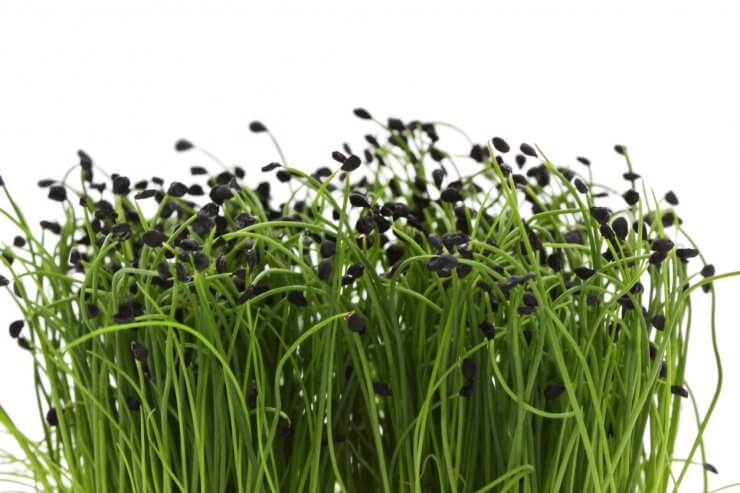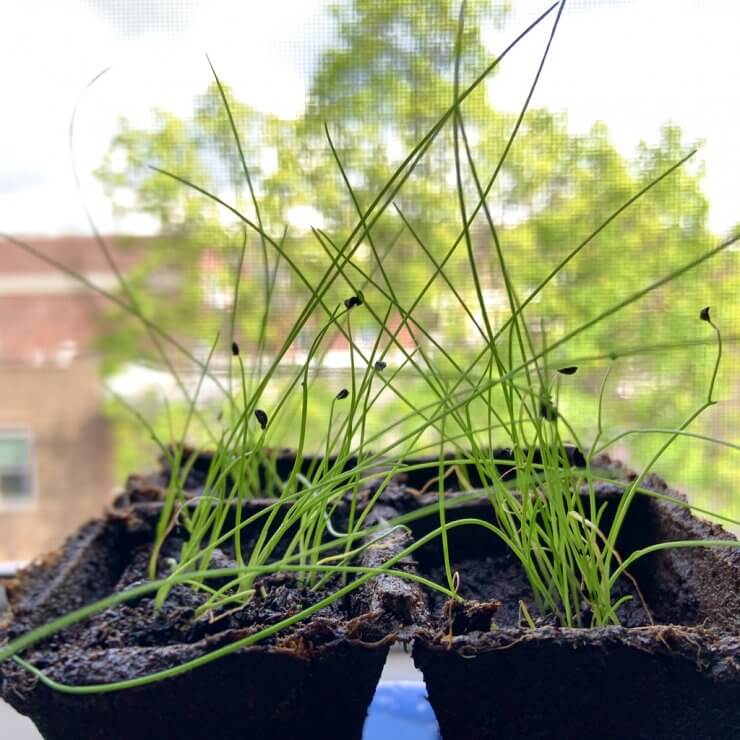
Garlic chive seedlings
You can grow chives from seeds, starts, or divisions (splits). If you have a fellow gardener with an ever-expanding chive patch, you could offer to help divide the plants and take some home for yourself. You can also get starts (clusters of seedlings) from local nurseries, extension centers, and online through some seed companies. Part of how you start your chives depends on your timing and location.
Seed Planting Process
Chive seeds take a week or two to germinate, so you’ll want to plan ahead. If you live in a cooler area, you’ll want to get started early.
Indoors

Chive seedlings growing indoors
Sow your chive seeds indoors eight to 10 weeks before your expected last frost date. For best results, use a seed starting formula. One of those seed starting kits is especially helpful, since you can add water to the tray below the compartments rather than dousing your seeds with water, which can lead to mold issues.
Sow the seeds about a quarter inch down in the seed starting mix. Keep the soil moist and at a temperature around 70 degrees F. Ensure continued warmth by using a plant heating mat under the seed tray.
Once your seedlings emerge, they are going to need plenty of light. Put them by a sunny window or turn on grow lights about 4 inches above your seedlings. Leave the lights on for 18 hours, off for eight hours. Don’t leave the lights on 24/7; most plants need a little darkness to grow.
When your seedlings are three to four weeks old, you can give them a solution of half-strength indoor plant food. Chives aren’t heavy feeders, so this is just to give them a good head start.
Before you head out to your garden to transplant your seedlings, they’re going to need about a week to go through the process of hardening off. This gets them used to living in the great outdoors.
Put your seedlings outside in a sheltered spot, safe from wind and blazing sun. If frost is in the forecast for the night, bring them inside. Then put them out again in the morning. After a week of this acclimation, they have a stronger cell structure and are ready to grow outside.
Sowing directly in the garden
Make sure your soil is properly prepared to receive the seeds (you got your soil tested, yes?). Wait until all danger of frost is past. If you live in a frost-free area, you can sow seeds from fall until early spring.
You want a 6 to 8-inch deep, weed-free planting area rich in organic matter. Sow your seeds evenly, about a half inch apart, and cover with a scant quarter inch of soil. Tamp the soil down gently and keep it evenly moist.
In a week or two, you should see seedling poking through the soil. When they get to be an inch or two tall, thin them to about 3 inches apart.
Growing from Starts or Splits
If you picked up some starts from your local nursery or extension center, or maybe the farmer’s market, you’re one step closer to enjoying chopped chives with your breakfast eggs. You can also transplant part of a larger clump of chives; check with your fellow gardeners to see if someone’s thinning out their chives. It’s easy to divide a plant—healthy, even, to give the bulbs room to stretch out.
The planting process for starts and splits is the same. Be sure your soil is adequately prepared, with 6 to 8 inches of rich soil ready and waiting. If your plant is in a pot, remove it gently. Loosen the root ball if it’s a little tight; this will help the plant settle in and get its roots in good growing order.
Dig a hole deep enough so that the root ball will sit even with the soil around it, and twice as wide so that you can easily fill in the soil without crowding the roots. Once your plant is in the ground, tamp down the soil around the plant so you make a slight depression; this will direct water to the roots.
Give your plant a long drink of water, so that little depression fills in. This first long drink helps your plant settle in, forces out any remaining air pockets, and keeps the new roots in good contact with the soil.
Don’t let your plants dry out, but after that initial settling-in long drink of water, don’t let the soil around your plants stay wet. Chives don’t like soggy soil.
Have you tried growing chives from seeds, starts, or splits? Which method do you prefer—and why? Please share your experiences with us.


 Previous
Previous

